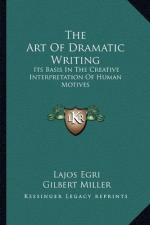
|
| Name: _________________________ | Period: ___________________ |
This test consists of 15 multiple choice questions and 5 short answer questions.
Multiple Choice Questions
1. The antagonist in a play or work of literature faces off against _____.
(a) The narrator.
(b) The pivotal character.
(c) The presentation.
(d) The forces of good.
2. Who is Nora's husband in "A Doll's House"?
(a) Krogstad.
(b) Dr. Linde.
(c) Dr. Rank.
(d) Torvald.
3. According to the author, a character must represent the influence his _____ has had on him.
(a) Education.
(b) Upbringing.
(c) Environment.
(d) Faith.
4. "Romeo and Juliet" begins with a feud between the Capulets and _____.
(a) The Moultons.
(b) The Mumfords.
(c) The Moreaus.
(d) The Montagues.
5. Who wrote "Oedipus Rex"?
(a) Aristotle.
(b) Plato.
(c) Xenophanes.
(d) Sophocles.
6. What does Lajos Egri claim is the premise of "Othello"?
(a) "Ruthless ambition leads to its own destruction."
(b) "Jealousy destroys itself and the object of its love."
(c) "Great love defies even death."
(d) "Love rewards death."
7. Aristotle was a student of _____.
(a) Plato.
(b) Xenophanes.
(c) Heraclitus.
(d) Socrates.
8. The author claims that a man's _____ will react to something that affects him physically more so than his body.
(a) Spirit.
(b) Conscience.
(c) Heart.
(d) Mind.
9. According to the author, you must present a character as _____.
(a) A principled person.
(b) An individual.
(c) An aesthetic.
(d) Beautiful.
10. In Book II, Character, Chapter 11: Unity of Opposites, the author creates a skit where an abandoned street dog makes friends with what?
(a) A woman.
(b) A boy.
(c) A man.
(d) A girl.
11. What does the author claim causes motion in Book II: Character, Chapter 3: The Dialectical Approach?
(a) Craziness.
(b) Kinetic energy.
(c) Commotion.
(d) Contradiction.
12. What term refers to a lack of conflict in a scene or play?
(a) Peace.
(b) Static.
(c) Drama.
(d) Boring.
13. A play, according to the author, will not work without what central figure who drives the action?
(a) Pivotal character.
(b) Antagonist.
(c) Hero.
(d) Protagonist.
14. What is Lajos Egri's terminology for the physiological, psychological, and sociological makeup of a character?
(a) Anatomy.
(b) Whole being.
(c) Bone structure.
(d) Skeleton.
15. What refers to the psychological classification of different types of individuals?
(a) Philosophy.
(b) Personality type.
(c) Attitude.
(d) Race.
Short Answer Questions
1. The Sophists taught what, meaning quality or excellence as the highest value and determinant of one's actions in life?
2. What refers to a settlement of differences by mutual concessions, an agreement reached by adjustment of conflicting or opposing claims?
3. What classical Greek Athenian philosopher was credited as one of the founders of Western philosophy and was known chiefly through the accounts of later classical writers, especially the writings of his students?
4. What refers to a dramatic form that does not observe the laws of cause and effect and that exaggerates emotion and emphasizes plot or action at the expense of characterization?
5. What is a method of argument that has been central to both Indic and European philosophy since ancient times and was made popular by Plato?
|
This section contains 442 words (approx. 2 pages at 300 words per page) |

|




